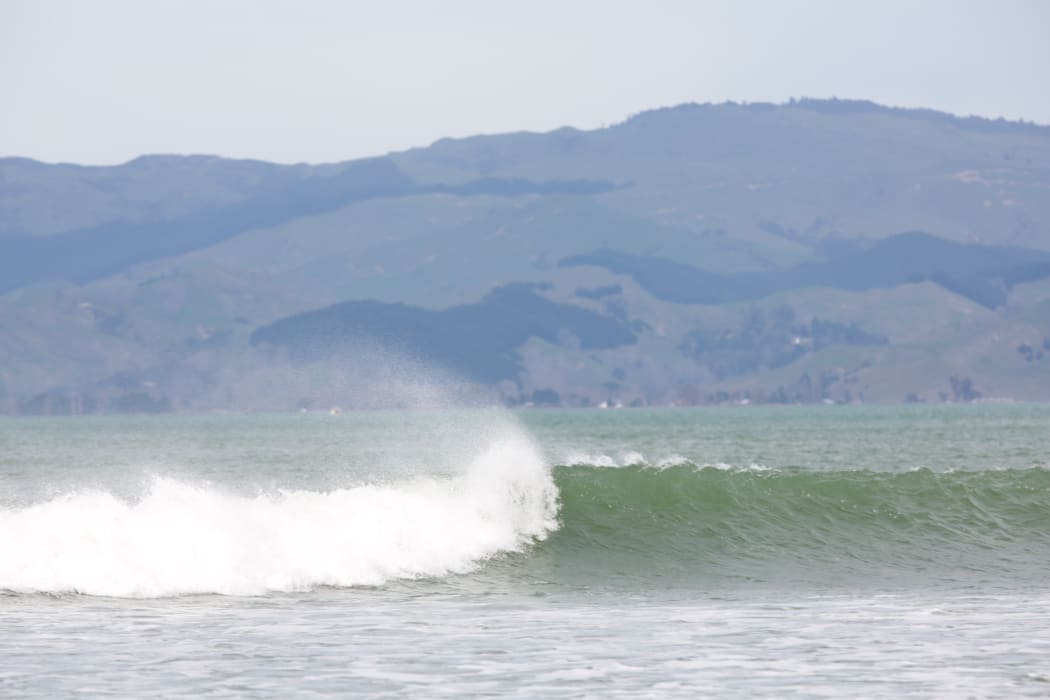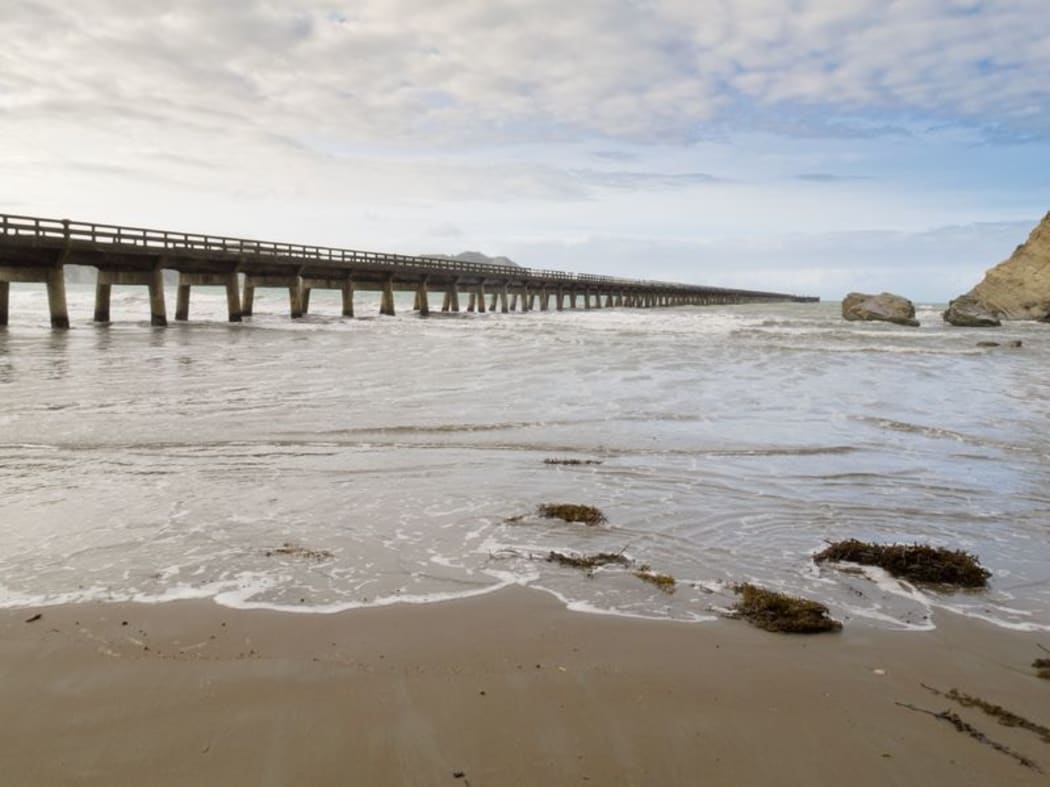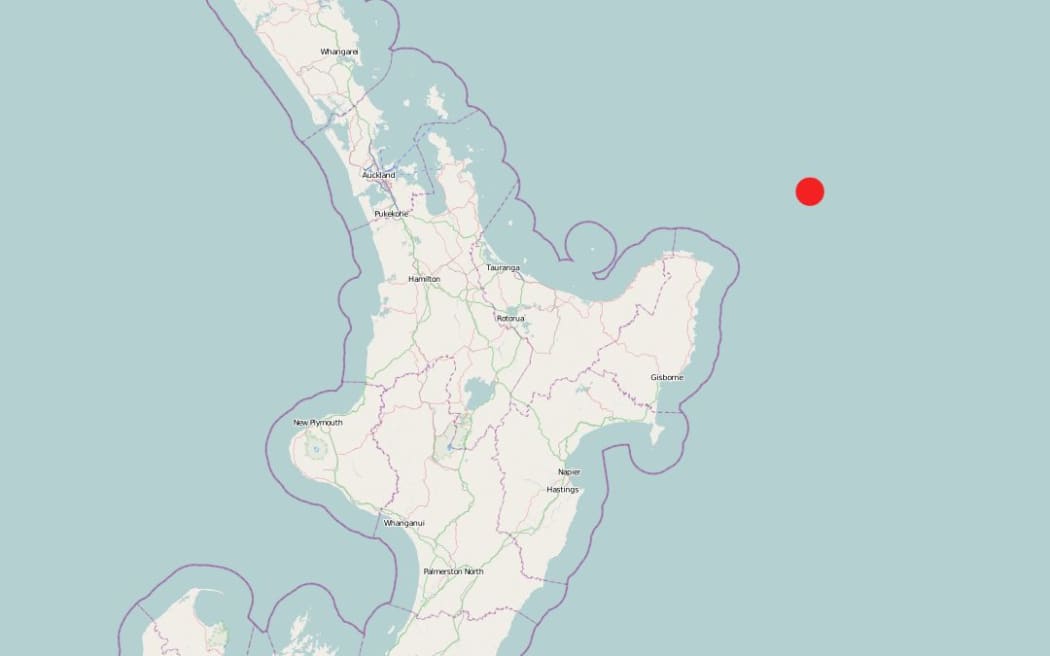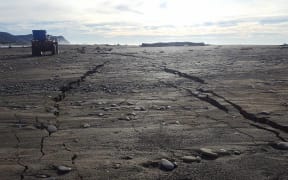The large earthquake which struck off the East Cape this morning increases the chance of other big earthquakes striking near the region, GNS is warning.
The 7.1-magnitude quake has already been followed by a magnitude 6.2 aftershock and there will be more, GNS warns.

Waves at Gisborne Beach this morning. Photo: RNZ / Cole Eastham-Farrelly
The first quake struck at 4.40am and was 130km north-east of Te Araroa and 55km deep. Since then there have been dozens of aftershocks.
Civil Defence earlier issued a tsunami warning, which has now been cancelled.
GNS Science seismologist Bill Fry said there was an increased chance of other big earthquakes striking near the region.
"We would expect a continuing sequence of magnitude fives, magnitude fours to happen in relatively the same location, with that activity spreading out over distance in the coming days and weeks," Dr Fry said.
"And everywhere around this earthquake, right now, we know that there's an increased likelihood of other large earthquakes."
The tremor was one of the most significant New Zealand had had for some time, he said.
Another large earthquake could trigger another tsunami threat, he said.
GNS scientist Anna Kaiser said the initial quake would have been felt fairly strongly by people in the area. GNS had received "felt" reports from across the North Island, she said.
With large quakes like the first jolt it was typical to get "low-frequency energy generated" which resulted in the "long-rolling motion" people had reported feeling.
GNS duty seismologist Caroline Holden said there was a definite possibility another jolt could occur onshore as there was a rupture line from the initial quake towards land.
"We're talking a magnitude 7 earthquake, it was 100km away, but the rupture would be about 40km long, as a first estimate, so it could be impacting closer to New Zealand than the 100km initial estimate.
"You do expect aftershock activity to occur in New Zealand closer to shore or onshore.
"We have at least 15 aftershocks that have been recorded and we can expect more. We have people working on untangling the whole aftershock sequence as we speak. It's quite a complex system," Dr Holden said.
However, Dr Holden said today's big quake was very unlikely to trigger quakes in other parts of New Zealand.
"We've had more than 10 moderate to large aftershocks, magnitude 5 and 6 recorded and felt throughout New Zealand. The largest one so far was measured 6 and occurred 30 to 45 minutes after the main shock."
Gisborne was an area of the country where people were used to earthquakes, but that came with a warning, she said.
"They should prepared for a very large event, so they should not be surprised by a very large earthquake and they should be very much prepared for one."
Dr Holden said the 6.6 earthquake movement in Gisborne in 2007 was much stronger than today's one.
"Recorded acceleration was twice what people experienced today in Te Araroa."
The region of Gisborne had been struck by three 'decent-sized' earthquakes in the last 50 years, she said.
CCTV from New World Whakatane (my work) #EQNZ pic.twitter.com/GR5RCgP0Ez
— Mitch (@MitchKinney) September 1, 2016
More CCTV from work #EQNZ pic.twitter.com/Ks4tPtDaJ4
— Mitch (@MitchKinney) September 1, 2016
Some images from work #eqnz pic.twitter.com/2M1PrW9lB6
— Mitch (@MitchKinney) September 1, 2016
Tsunami threat over
The Ministry of Civil Defence & Emergency Management (MCDEM) said based on all available data, the greatest tsunami activity had passed.
The tsunami warning had applied to the north coast of the North Island, including Northland, Auckland, Waikato/Coromandel, Bay of Plenty and the East Coast down to Mahia Peninsula.
An earlier warning that included the upper South Island and the rest of the North Island east coast had been lifted earlier this morning.
Coasts may still experience unusual, strong currents and sea level fluctuations lasting for several more hours, the Ministry said.

Civil Defence has warned people should stay away from the water. Photo: 123RF
Civil Defence's warning said waves measuring 30cm high were initially measured at the East Cape and Great Barrier tide gauges.
It had not received any reports of injuries or damage from the earthquake or waves.
Gisborne Civil Defence said people who lived on the coast could return to their homes, after earlier being told to leave, but must stay away from beaches and waterways. Should they feel another long or strong quake, they should again head for higher ground or as far inland as possible.
KiwiRail issued a precautionary shutdown notice for part of Auckland's rail network, briefly closing Britomart Station and the lines to Newmarket.
They had now reopened but it was causing a run-on effect and disruptions for other lines.
Civil Defence public information officer Sheridan Gundry said the emergency management centre had been activated.
There is a potential tsunami threat for New Zealand following the 7m earthquake near Te Araroa at 4.38NZ time today. #eqnz
— MCDEM (@NZcivildefence) September 1, 2016

A 7.1 earthquake has hit northeast of Gisborne, and residents have been urged to evacuate to higher ground. Photo: Geonet
Several schools in Gisborne will be closed for the day, despite the warning being lifted.
Tolaga Bay Area School and Waikirikiri School told RNZ they would stay closed because of how close they were to the coast.
Erana Keelan-Reedy, from Radio Ngati Porou, said Te Kura Kaupapa Maori O Kawakawa Mai Tawhiti was also closed.
Waves arrived quickly
GNS seismologist Bill Fry said the proximity of the earthquake to New Zealand meant everything had happened fast.
"It's quite a quick wave train ... and the waves have decayed - the largest waves have come and gone.
"Tsunami waves were not small, cresting waves that broke on the beach, but "a very, very rapid rise in sea level", Dr Fry said.
It was difficult to compare the situation to other recent tsunami warnings because those warnings had been generated by large earthquakes in the distant Pacific.
"It happened very locally and it means the waves hit much more quickly," he said.
"We have much less analysis and much less information than we would if it was travelling a long distance."
People wake to 'wobbling' earthquake
People have described the shaking as a north to south wobbling movement or a low growling rumble then a vibration.
The lines company for Gisborne, Wairoa and the East Coast says the quake caused two power outages in the region.
Eastland Network says the outages were near Rototahi and Waimata but power has since been restored to the 300 affected homes.
The Transport Authority is warning motorists in the eastern Bay of Plenty there's an increased risk of rock-falls and slips.
It said contractors had been monitoring and surveying the highway network.
No damage or rock-falls have been reported, but the aftershocks were bringing an increased risk of rock-fall and slips on stretches of state highways 2 and 35.
RNZ listeners reported feeling the quake as far south as Akaroa and as far North as Kerikeri in Northland.
Lindsay in Whakatane said the quake woke him up and he took cover.
"Finally I ended up getting up and taking cover under doorways and whatever. We had things like sliding doors rattling on their tracks and one item fell off a shelf," he said.
It followed a smaller 5.7 earthquake which hit the area about 10am yesterday.
Te Araroa eq is updated to a M7.1 EQ, 100km NE of Te Araroa. The tsunami experts panel has been activated. Check @NZcivildefence for advice
— GeoNet (@geonet) September 1, 2016
People in coastal areas should stay out of the water. Stay off beaches and shore #eqnz
— MCDEM (@NZcivildefence) September 1, 2016
Still feeling aftershocks way up in the Waitakere Ranges in Auckland. #eqnz #earthquake
— Simon Smith (@WordSmithNZ) September 1, 2016
Long and deep shaking in Whakatane, but everyone seems to be fine. #eqnz
— Arctosia (@Arctosia) September 1, 2016
We are currently assessing the situation following the 7.1m quake near Te Araroa. #eqnz
— MCDEM (@NZcivildefence) September 1, 2016



